A STORY ABOUT
“NDIMU” aka LIME
A language barrier
As usual in the past years
we have spent our winter holiday at the South Coast of Mombasa (
We got the same room on the
first floor in one of several hotel blocks as in the past visits. From
the
balcony there is a splendid view of the white sandy beach below, the
lagoon,
and the reef some 500m away, after which it stretches to the wide
We have booked a half-board
accommodation that suited us well as we could stay at the beach from
breakfast
until
In the late afternoon we
returned to our room but the substitute for the bottle of red wine had
not
arrived yet. During dinner, we ordered a
bottle of water with limes cut in halves, but again we got lemon slices
instead. The new waiters were somehow mystified, as none of them could
understand our complaint. The head waiter we knew from previous visits
told us
that the kitchen and bars don't have limes as the new F&B-manager
wouldn't
buy them. On earlier visits we got any number of limes, either from the
stores
or from some staff members' gardens - clean fruit without any
pesticide's
treatment. By Jove, why couldn't we get the limes that grow in
abundance along
the coast here?
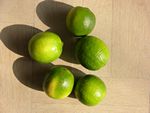
Next morning I complained at
the guests' relation desk, asking when we would get the lime fruit for
the
returned bottle of red wine. Later on the beach Ljiljana saw a woman
carrying
baskets with some fresh bananas, lemons, papayas, etc. She asked if she
could
bring a few "limao" later the same afternoon. In fact, the woman
brought some kind of green looking fruit with rough thick skin, which
we
guessed to be more a wild lemon or something unknown. Ljiljana took a
dozen of
them, feeling that she was let down with "limao" for sure. She cut
the fruit's thick skin, more a buffalo hide than lime skin, and she
could
hardly squeeze any drops out of it. So "limao" is certainly not
"lime" in Swahili.
Another surprise for us was
a bottle of "Roses" lime syrup that stood proudly on the room desk.
If you ever tried this syrup you would know that it is very sweet and
hardly
has any taste of lime as such. It is used in cocktails and is certainly
not
meant to be diluted in drinking water as a fresh lime juice supplement.
We both
got rather upset so it was decided that I take the "Roses" bottle and
go to complain at the guests' relation desk again. For the first time
we were
let down using fresh lime fruit juice for more than 40 years after we
learned
about its benefit and enjoyment.
Long ago, Ljiljana was
buying dozens of fresh lime fruits - green to yellowish with smooth,
thin skins
- at
In a bad temper I arrived at
the guests' relation desk and was greeted by the smiling PR manager, a
coastal
man whom we knew well from our previous visits. He listened carefully
to my
exasperation about fresh limes and took the "Roses" bottle with
obvious resentment. He promised that he would see that we had fresh
limes at
the dining table and that he would send some to the room too. He told
me the
Swahili name for lime is "ndimu", explaining that the new employees
from Upcountry wouldn't know the lime fruit as such. Even if we had
asked a new
waiter from Upcountry to bring us "ndimu", he would not have known
what we were talking about.
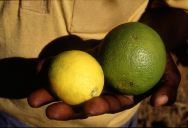
We met the new F&B
manager after dinner and in the conversation I asked why we couldn't
get
"ndimu" with the drinking water, getting lemon instead. Obviously the
gentleman didn't know what "ndimu" was, so another supervisor who
joined us resolved the mystery about the lime fruit, alias ndimu, for
all. We
got a firm promise that limes cut in halves would be served to us with
every
meal during the rest of our stay.
We had the permission to get
any amount of fresh limes from any employee's garden as required for
use at home
later. Thus we became known as the guests nicknamed "rafiki
ndimu" (friends of ndimu).
Epilogue:
Our old ndimu suppliers were
happy to provide Ljiljana with a considerable amount of lime fruits
from their
gardens. The fruit was fresh smelling nicely and full of juice and we
took some
150 pieces home. Back home the fruit was washed in a manageable number,
cut in
halves and the juice pressed out, placed in small boxes and placed in a
deep
freeze afterwards. The remaining skins were kept in clear water for a
while,
then hand-squeezed for their aromatic oils and this concentrate was
kept apart
in the refrigerator for subsequent usage. One should add a little of
this
aromatic oily dilution into the lime juice mix with fresh water because
the
aromatic oils do taste a little bit bitter.
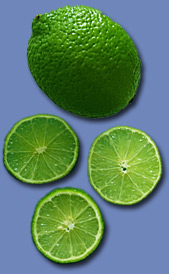
A fresh lime with a few thin slices with seeds at center.
Our personal usage of lime:
as treatment of cuts and scratches on coral rock (some are poisonous)
and stops
bleeding in a short time. A cut heals up in a few days leaving hardly
any
visible scar. One can use lime juice as a disinfectant due its large
C-vitamin
content in cases of throat or stomach ailments.
Explanations about various
plants:
1. LIMAO alias
LEMON
Citrus limon (L.) Burm. f.; Syn. Citrus
medico L. var. limon
(L.) Osb.
Rue
family - RUTACEAE
First information from
2. NDIMU alias
LIME
Citrus
aurantiifolia (Christm.)
Swingle
Rue
family - RUTACEAE
Literature: COLLINS' GUIDE to Tropical Plants by Wilhelm Loetschert
& Gerhard Buse. Publisher: Collins,
~ ~
~
I have
found more data about the Lime alias
Citrus aurantiifolia in searching the Internet. I believe that it
is good
enough to be mentioned here too.
Lime
propagates itself from seeds. This evergreen tree is small, spiny and
irregularly branched and has small elliptic to oblong leaves are pale
green.
The white flowers are also small and produced in auxiliary clusters.
The fruit
is small, spherical or egg-shaped and thin-skinned having about 10
juicy
sections that contain greenish seed leaves. The juice is acid with a
distinctive flavor. Limes are gathered when fully grown, but still
green, and
shipped very soon after.
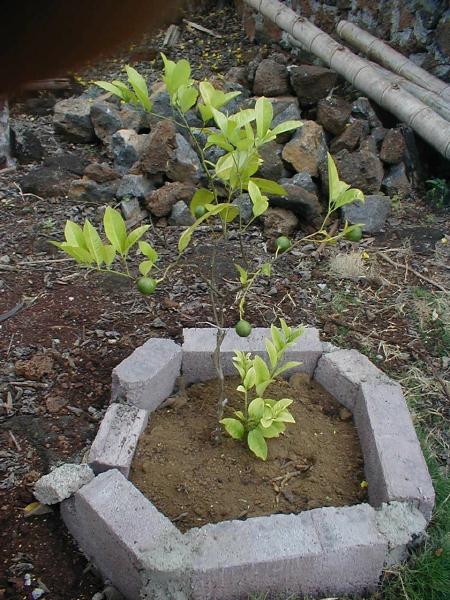
A young lime tree planted in an orchard.
The
seeds, usually collected separately in the factory, are rich in fat and
should
be mixed with the skins for feeding to cattle. Because of the toxic
factors in
the seeds, they should not be fed to poultry and should be fed to pigs
with
care as they tend to produce soft fat. Ruminants can tolerate them too.
If lime
skins are fed in large quantities to dairy cows, the morning milk may
have a
slight off-flavor and be opalescent. According to farmers who use them
as
need, lime seeds give animal fur a glossy shine and rid cattle of ticks.
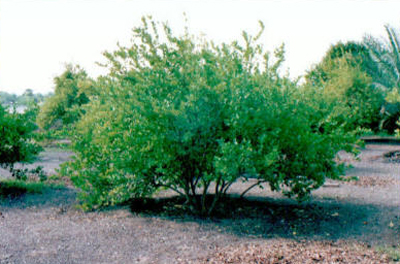
According
to <http://www.heilfastenkur.de/Limette.shtml>
lime contains the following substances: Essential oils (Bergapten, Citral,
Linaool, Linalylacetat,
Pinen, Sabinen,
and Turpentine);
Minerals (Potassium, Calcium, Magnesium, Natrium, and Phosphor); Vitamins (Foal-acid,
vitamins A & C & E, Retinol, and Tocopherol).
The therapeutic qualities are: antiseptic,
antimicrobial, antioxidant, anti-rheumatic, anti-depressive, and
contracting.
Lime (Citrus aurantifolia)
is presumably indigenous in
The lime is present on the
In
At last some common names in
a selection of various languages
English: Key lime, lime,
Mexican lime, West Indian lime
Fijian: laimi,
moli kara,
moli laimi
French: citron vert, limettier, limier
German: Limette
Maori (
Niuean: sipolo fau ikiiki
Samoan: moli
tipolo, tipolo,
tipolo
Spanish:
Tahitian: taporo, te
tumu taporo